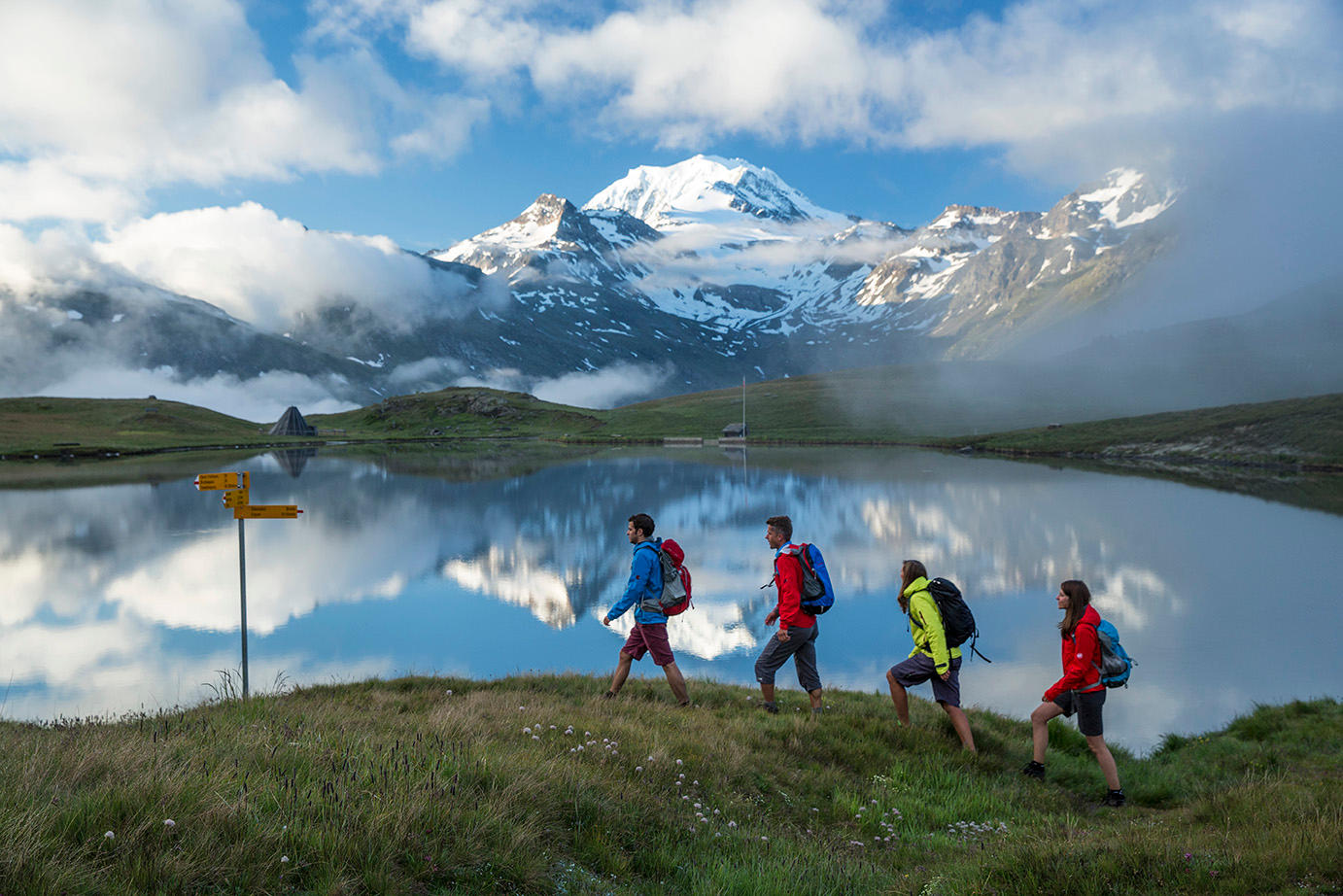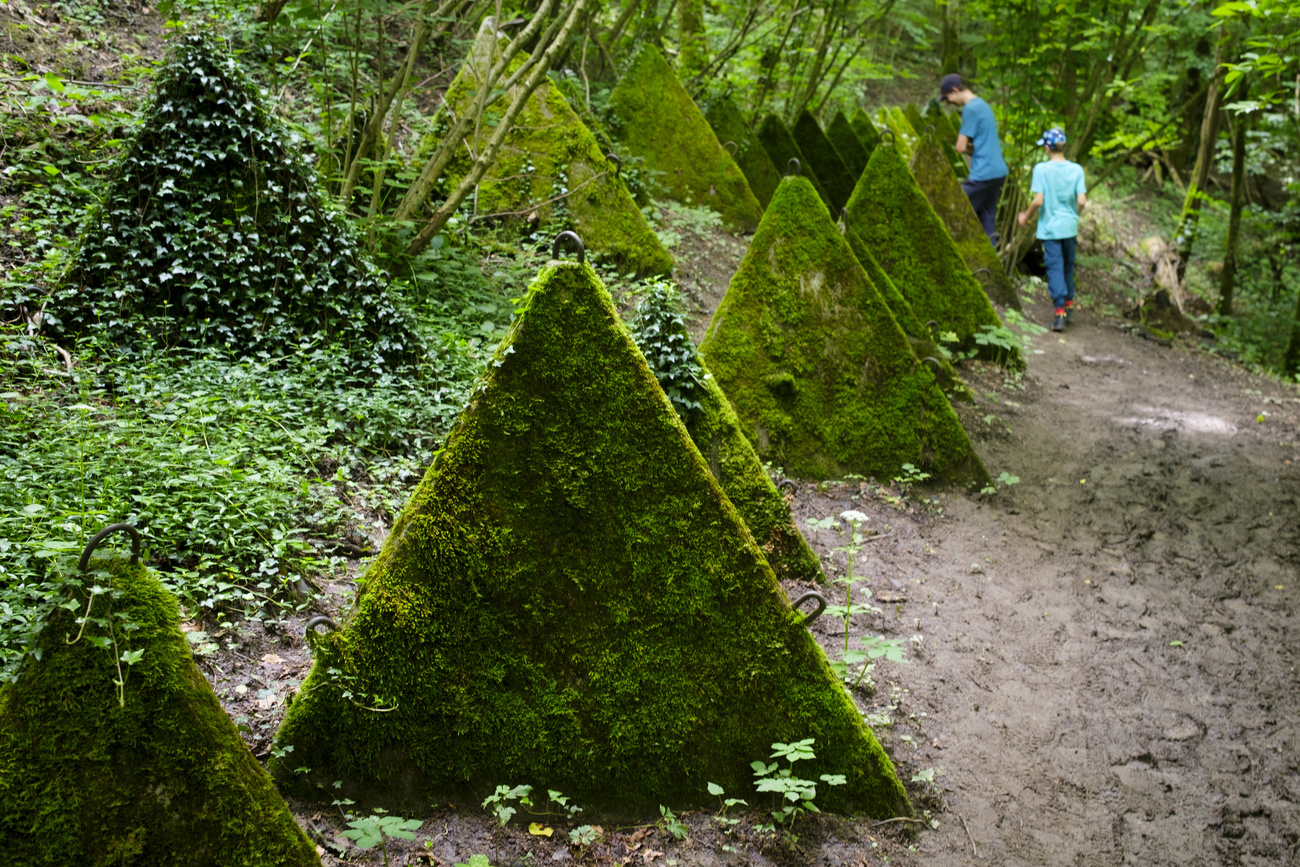
Swiss hiking trails – unique but under pressure

A federal law on hiking trails came into force exactly 40 years ago. The trails are more popular than ever but are suffering the consequences of overuse by hikers and cyclists as well as extreme weather conditions.
Do you enjoy hiking? Perhaps right now, in the golden autumn, when the leaves change colour and the forests are bathed in a sea of colour? Switzerland is certainly one of the most popular countries for wandering in nature.
Why is that? Let’s start with some figures: You can indulge your wanderlust on more than 65,000 kilometres in Switzerland. For comparison: according to the Federal Statistical Office (FSO), Switzerland has 85,000 kilometres of roads and 5,300 kilometres of railways.
Almost two-thirds (62%) of these footpaths are accessible to all (signposted with the familiar yellow signposts), 36.5% are mountain hiking trails marked in white-red-white, and 1.5% are Alpine hiking trails with white-blue-white signposting.

Mountain and Alpine hiking trails require surefootedness, a head for heights and a good level of fitness.
The network is also divided into national, regional and local routes: National routes can be hiked in one-month tours or in sections, regional routes in two to three days and local routes are suitable for day hikes.
Around 50,000 signposts have been erected throughout the country. Maintaining them costs an average of around CHF800 ($1,000) per kilometre. Around 2,000 volunteers are involved in this work.

More
What you need to know about hiking in Switzerland
One difference to many other countries is the fact that Swiss hiking signposts indicate the duration of a hike up to a certain point.
This is based on an average hiking speed of 4.2km/h – not including breaks, of course.
In the Federal Constitution for 40 years
But enough of the figures. What makes the Swiss hiking trail network unique in the world is that it is enshrined in law in the Federal Constitution: the Federal Act on Footpaths and Hiking Trails from 1985 regulates the planning, construction, maintenance and replacement of interconnected footpath and hiking trail networks in Switzerland.
The Federal Act has been in force since October 4, 1985, so for exactly 40 years. However, this doesn’t automatically mean that the federal government is responsible for the path network.
As with so many issues in Switzerland, it is the cantons. That is why there are 26 specialist hiking trail organisations.
According to the Federal Act on Footpaths and Hiking Trails, the cantons are primarily responsible for the planning, maintenance, financing and signposting of hiking trails. However, they can also delegate the construction and maintenance in particular to the municipalities. This is the rule in most cantons.
Digital preparation
Die-hard hikers know that good preparation is the be-all and end-all of a tour. Switzerland Mobile, the official network for non-motorised transport for leisure and tourism in Switzerland, and the Federal Office of Topography Swisstopo, among others, simplify planning with their online tools.

More
The Toblerone Trail: a unique walk through Swiss history and nature
Jan Gilar, a recent immigrant to Switzerland from the Czech Republic, experienced just how important this is this summer. Unprepared, he set off on a glacier hike – and fell eight metres into a crevasse.
It was only thanks to the steadfastness of his tiny dog Philipp, who stayed on a stone next to the crevasse, that Air Zermatt was able to locate and rescue Gilar after a 40-minute search. A tourist had heard his distress call on a walkie-talkie and organised help.

Hiking in Switzerland
But how did Switzerland become a country of hikers? Around 1900, the Swiss population’s need for recreation in nature grew.
With the spread of cars in the 1920s, pedestrians felt increasingly marginalised. Teacher Jakob Ess began marking hiking trails on his own initiative – initially without a standardised system.

In 1933, Ess and Otto Binder founded the Zurich Working Group for Hiking Trails. Just one year later, the Swiss Hiking Trail Association was founded at national level.
On the day it was founded, a standardised signpost was established: the yellow signs with black lettering that are still used today to mark official hiking trails.
During the Second World War, the army removed all signposts for security reasons. However, the board used the time to plan new routes and prepare markings so that the network could be quickly re-established after the end of the war.
Since then, it has grown from year to year and become increasingly popular. According to a study by Swiss Hiking Trails, around four million people aged 15 and over went hiking regularly in 2019.
This equated to 58% of the resident population. In total, around 80% used the network. The surveys were conducted before the Covid pandemic.
The boom and its downsides
The hiking boom increased significantly during the pandemic – and it is continuing to do so.
But success also has its downsides: recently, some cantons and municipalities have been struggling to maintain all their hiking trails. In mountain cantons in particular, certain trails occasionally have to be closed.

The many hikers are not the only reason for this. The trails are also being used more and more by people on mountain bikes and e-bikes. Added to this are environmental factors such as natural phenomena and heat, which are increasing all the time.
Excessive heat can also cause the ground to harden and the root network of trees to weaken, making them unstable and a real danger to humans and animals.

For many municipalities, the additional maintenance costs mean a growing financial and personnel burden. This is why parliamentarian Manfred Bühler asked the government in the summer session whether there was a support fund for municipalities facing high costs.
In its reply in mid-August, the government pointed out that municipalities and organisations could apply for money from the donation-financed hiking trail fund of the specialist organisation Swiss Hiking Trails.
The government said it didn’t have its own support fund for hiking trails and saw no scope for additional financial relief for the cantons and municipalities in view of the tight federal budget situation. The ball is therefore still in the regions’ court.
Edited by Balz Rigendinger. Translated from German by DeepL/ts
More

In compliance with the JTI standards
More: SWI swissinfo.ch certified by the Journalism Trust Initiative































You can find an overview of ongoing debates with our journalists here . Please join us!
If you want to start a conversation about a topic raised in this article or want to report factual errors, email us at english@swissinfo.ch.